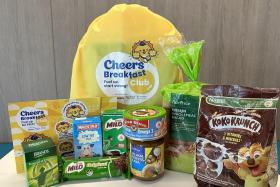More interaction, technology for mother tongue classes
Curriculum for lower primary pupils tweaked to foster love for language
While drawing on a tablet, eight-year-old Destinee Tan occasionally collapsed in giggles with her group mates.
It was a classroom assignment, and the pupils were tasked to draw the flora and fauna found in a garden. They were then asked to present what they had drawn.
Destinee is more comfortable speaking English, but classroom assignments such as this allow her to practise her mother tongue language (MTL) more.
"I enjoy Chinese lessons because they are fun. I like the drawing and writing," the Primary 2 pupil said in Mandarin.
This is what a typical Primary 2 Chinese lesson looks like at Greenwood Primary School (GWPS). It is part of a new MTL curriculum.
Tweaked in 2015, it has been implemented at the lower primary levels. It will be rolled out progressively to all other levels by 2020, said a Ministry of Education (MOE) spokesman.
The focus of the new curriculum at the lower primary level is to help pupils be better at speaking, listening and everyday interactions.
The spokesman said: "It aims to enable our young to communicate more effectively in their respective MTLs, better appreciate our cultural roots and connect with other communities in Asia and beyond."
The new curriculum comes after a raft of changes introduced in 2011 - a reaction to the trend of English becoming the dominant language in homes.
For instance, the picture description and conversation segment in this year's PSLE oral examination will be replaced by video conversation.
At GWPS, MTL programmes are designed to reflect the school's belief that languages should come alive.
Principal Cheryl Foo told TNP: "To love the language is not just learning to pass the examination and assessment but to love the language as a whole, of how it has impacted us socially. So we look into the history of the language."
To engage "21st-century learners", MTL classes heavily feature technology too, Ms Foo added.
For instance, pupils are selected to answer questions via a random name generator a la Wheel Of Fortune. They then get to do a show-and-tell, or they sing and dance while learning new vocabulary.
'DIVERSE'
"We are looking at children who are diverse. They probably had a lot of exposure in terms of information and communication technology and the media.
"Hence, the teaching and learning pedagogy need to be more innovative to cater to the children's needs," Ms Foo said.
With this new approach, MTL teacher Woo Wai Yin finds her role changing.
She told TNP: "I see myself as a facilitator, helping them to cope, learn independently and see the link between what they have learnt in the classroom and application in real life.
"This helps them learn effectively by themselves and prepare themselves for the future."
Get The New Paper on your phone with the free TNP app. Download from the Apple App Store or Google Play Store now



